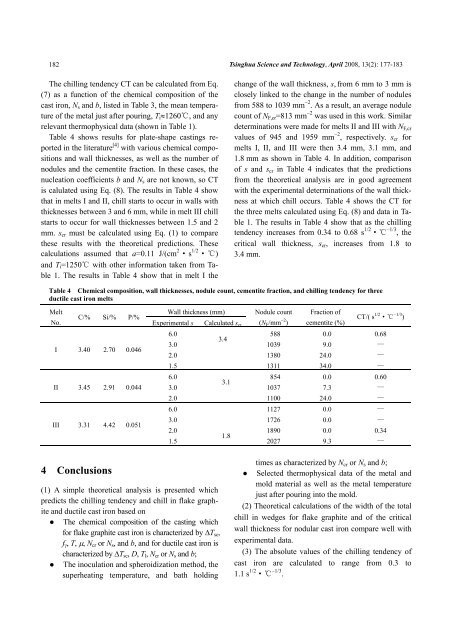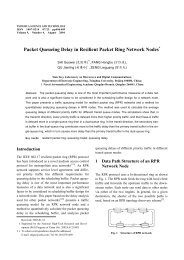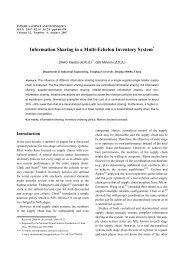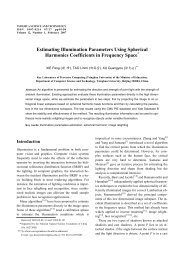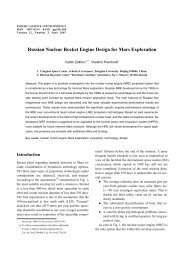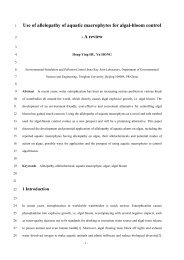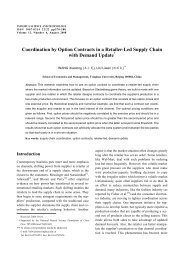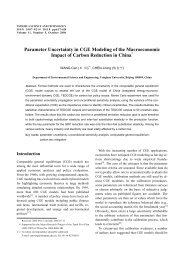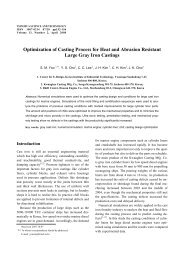Chilling Tendency and Chill of Cast Iron
Chilling Tendency and Chill of Cast Iron
Chilling Tendency and Chill of Cast Iron
You also want an ePaper? Increase the reach of your titles
YUMPU automatically turns print PDFs into web optimized ePapers that Google loves.
182<br />
The chilling tendency CT can be calculated from Eq.<br />
(7) as a function <strong>of</strong> the chemical composition <strong>of</strong> the<br />
cast iron, Ns <strong>and</strong> b, listed in Table 3, the mean temperature<br />
<strong>of</strong> the metal just after pouring, Ti≈1260℃, <strong>and</strong> any<br />
relevant thermophysical data (shown in Table 1).<br />
Table 4 shows results for plate-shape castings reported<br />
in the literature [4] with various chemical compositions<br />
<strong>and</strong> wall thicknesses, as well as the number <strong>of</strong><br />
nodules <strong>and</strong> the cementite fraction. In these cases, the<br />
nucleation coefficients b <strong>and</strong> Ns are not known, so CT<br />
is calulated using Eq. (8). The results in Table 4 show<br />
that in melts I <strong>and</strong> II, chill starts to occur in walls with<br />
thicknesses between 3 <strong>and</strong> 6 mm, while in melt III chill<br />
starts to occur for wall thicknesses between 1.5 <strong>and</strong> 2<br />
mm. scr must be calculated using Eq. (1) to compare<br />
these results with the theoretical predictions. These<br />
calculations assumed that a=0.11 J/(cm 2 ·s 1/2 · ℃ )<br />
<strong>and</strong> Ti=1250℃ with other information taken from Table<br />
1. The results in Table 4 show that in melt I the<br />
Tsinghua Science <strong>and</strong> Technology, April 2008, 13(2): 177-183<br />
change <strong>of</strong> the wall thickness, s, from 6 mm to 3 mm is<br />
closely linked to the change in the number <strong>of</strong> nodules<br />
from 588 to 1039 mm −2 . As a result, an average nodule<br />
count <strong>of</strong> NF,cr=813 mm −2 was used in this work. Similar<br />
determinations were made for melts II <strong>and</strong> III with NF,cr<br />
values <strong>of</strong> 945 <strong>and</strong> 1959 mm −2 , respectively. scr for<br />
melts I, II, <strong>and</strong> III were then 3.4 mm, 3.1 mm, <strong>and</strong><br />
1.8 mm as shown in Table 4. In addition, comparison<br />
<strong>of</strong> s <strong>and</strong> scr in Table 4 indicates that the predictions<br />
from the theoretical analysis are in good agreement<br />
with the experimental determinations <strong>of</strong> the wall thickness<br />
at which chill occurs. Table 4 shows the CT for<br />
the three melts calculated using Eq. (8) <strong>and</strong> data in Table<br />
1. The results in Table 4 show that as the chilling<br />
tendency increases from 0.34 to 0.68 s 1/2 ·℃ –1/3 , the<br />
critical wall thickness, scr, increases from 1.8 to<br />
3.4 mm.<br />
Table 4 Chemical composition, wall thicknesses, nodule count, cementite fraction, <strong>and</strong> chilling tendency for three<br />
ductile cast iron melts<br />
Melt<br />
No.<br />
C/% Si/% P/%<br />
I 3.40 2.70 0.046<br />
II 3.45 2.91 0.044<br />
III 3.31 4.42 0.051<br />
4 Conclusions<br />
Wall thickness (mm)<br />
Experimental s Calculated scr<br />
(1) A simple theoretical analysis is presented which<br />
predicts the chilling tendency <strong>and</strong> chill in flake graphite<br />
<strong>and</strong> ductile cast iron based on<br />
The chemical composition <strong>of</strong> the casting which<br />
for flake graphite cast iron is characterized by ∆Tsc,<br />
fγ, T, µ, Ncr or Ns, <strong>and</strong> b, <strong>and</strong> for ductile cast iron is<br />
characterized by ∆Tsc, D, Tl, Ncr or Ns <strong>and</strong> b;<br />
The inoculation <strong>and</strong> spheroidization method, the<br />
superheating temperature, <strong>and</strong> bath holding<br />
Nodule count<br />
(NF/mm −2 )<br />
Fraction <strong>of</strong><br />
cementite (%)<br />
CT/( s 1/2 ·℃ –1/3 )<br />
6.0 588 0.0 0.68<br />
3.4<br />
3.0<br />
1039 9.0 —<br />
2.0 1380 24.0 —<br />
1.5<br />
1311 34.0 —<br />
6.0 854 0.0 0.60<br />
3.1<br />
3.0<br />
1037 7.3 —<br />
2.0 1100 24.0 —<br />
6.0 1127 0.0 —<br />
3.0<br />
1726 0.0 —<br />
2.0 1890 0.0 0.34<br />
1.8<br />
1.5<br />
2027 9.3 —<br />
times as characterized by Ncr or Ns <strong>and</strong> b;<br />
Selected thermophysical data <strong>of</strong> the metal <strong>and</strong><br />
mold material as well as the metal temperature<br />
just after pouring into the mold.<br />
(2) Theoretical calculations <strong>of</strong> the width <strong>of</strong> the total<br />
chill in wedges for flake graphite <strong>and</strong> <strong>of</strong> the critical<br />
wall thickness for nodular cast iron compare well with<br />
experimental data.<br />
(3) The absolute values <strong>of</strong> the chilling tendency <strong>of</strong><br />
cast iron are calculated to range from 0.3 to<br />
1.1 s 1/2 ·℃ –1/3 .


